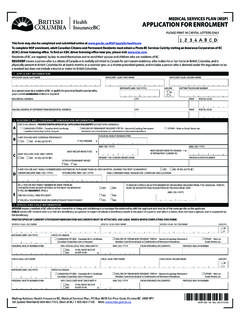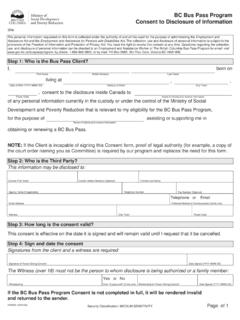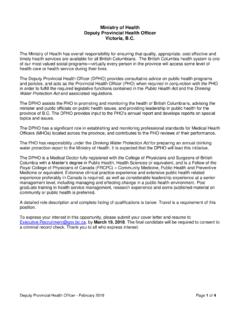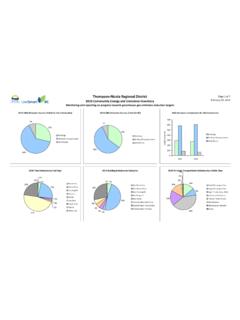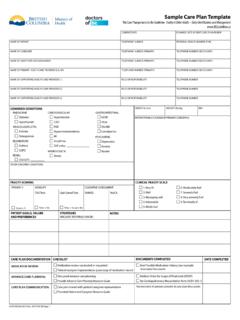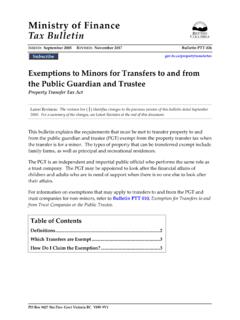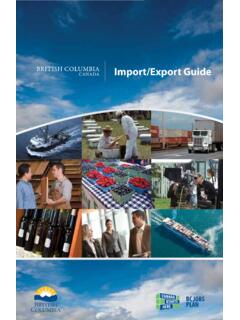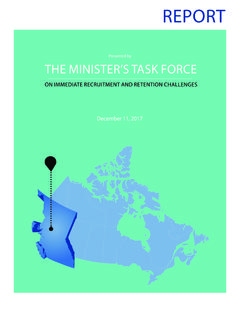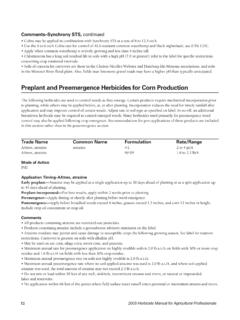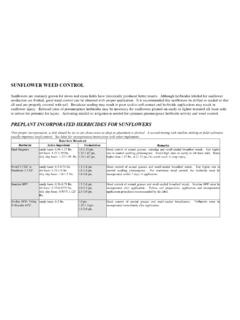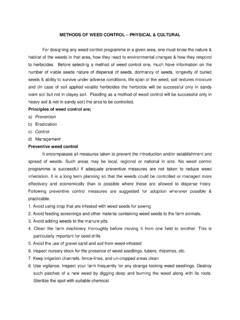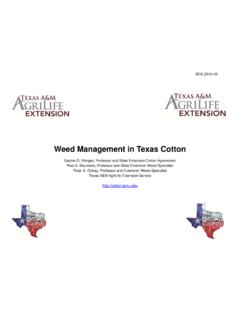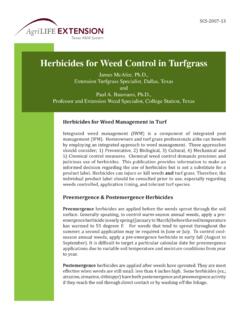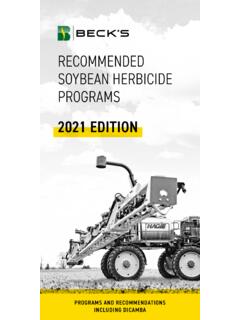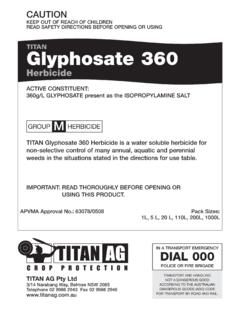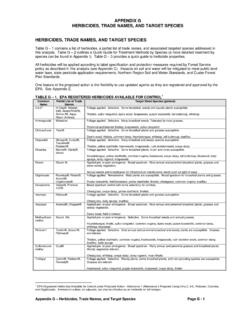Transcription of About Pesticides: Types, Names and ... - British Columbia
1 1 About pesticides : Types, Names and Formulations April 2017 What are pesticides ? pesticides are necessary tools used for managing damaging and invasive pests in agriculture, forestry and the landscape. pesticides include all materials that are used to prevent, destroy, repel, attract or reduce pest organisms. Insecticides, herbicides , fungicides and rodenticides are some of the more well-known pesticides . Others include growth regulators, plant defoliants, surface disinfectants and some swimming pool chemicals. Under federal legislation, all pesticides used in Canada must be registered by Health Canada. This includes all types of pesticides used in both conventional and organic production systems, whether they are manufactured or naturally occurring.
2 Pesticide Names pesticides are named three ways: by active ingredient, by trade name, and by chemical name. The active ingredient is the chemical that controls the pest. The name of the active ingredient is also known as the common name and is written beside the guarantee on a pesticide label. The trade name is the brand name that the manufacturer gives to the pesticide. The trade name is the prominent name on the front of a pesticide label. pesticides with different trade Names can contain the same active ingredient, and some pesticides have more than one active ingredient. The chemical name is the name of the chemical structure of the active ingredient and is used by scientists.
3 Types of pesticides pesticides can be grouped or classified in several different ways, including by the pests they control , their chemical structure, how/when they work, or their mode of action (site of action). Classification by Target Pest Species Most pesticides may be classified according to the pests they kill. The word ending or suffix -cide means to kill. The following types of pesticides are used to kill specific kinds of pests: Pesticide Pest Controlled Pesticide Pest Controlled algicide - algae miticide - mites avicide - birds molluscicide - snails, slugs bactericide - bacteria nematicide - nematodes fungicide - fungi piscicide - fish herbicide - weeds rodenticide - rodents insecticide - insects Example.
4 Glyphosate is the common name of a herbicide active ingredient Roundup is one of the many trade Names for herbicide products containing glyphosate N-(phosphonomethyl) glycine is the chemical name of the active ingredient in Roundup 2 Classification by Chemical Structure pesticides can be grouped according to chemical structure. pesticides with similar structures have similar characteristics and usually have a similar mode of action. Grouped by Mode of Action (MOA) pesticides can be grouped according to their mode of action or the way a pesticide controls the target pest. This is also referred to the primary site of action. For example, one insecticide may affect an insect s nerves while another may affect moulting.
5 One herbicide may mimic the plants growth regulators and another may affect the plants ability to convert light into food. The MOA of a pesticide is listed on the label as a group number or letter. Products with a similar MOA will have the same group number. Biopesticides include microbial pesticides (containing a live bacterium, fungus, virus, protozoan, or alga as the active ingredient), and chemicals derived from animals, bacteria, fungi and plants. A common biopesticide is Bacillus thuringiensis (Bt), that has different strains to specifically control caterpillars, mosquitoes, or beetles. Grouped by How or When They Work pesticides can also be classified according to how or when they work.
6 Contact pesticides generally control a pest as a result of direct contact. Insects are killed when sprayed directly or when they crawl across surfaces treated with a residual contact insecticide. weed foliage is killed when enough surface area is covered with a contact herbicide. Systemic pesticides are pesticides which are absorbed by plants or animals and move to untreated tissues. Systemic or translocated herbicides move within the plant to untreated areas of leaves, stems or roots. Systemic insecticides or fungicides move throughout treated plants and kill certain insects or fungi. Some systemic insecticides are applied to animals and move through the animal to control pests such as warble grubs, lice, or fleas.
7 Some pesticides only move in one direction within the plant, either up or down. Some pesticides are considered locally systemic. These will only move a short distance in a plant from the point of contact. Foliar pesticides are applied to plant leaves, stems and branches. Soil-applied pesticides are applied to the soil. Some are taken up by roots and translocated inside the plant. Other soil-applied herbicides kill weeds by affecting the germinating seedling. Most soil applied pesticides require tillage or water to move them into the soil. Fumigants are chemicals that are applied as toxic gas or as a solid or liquid which forms a toxic gas. The gas will penetrate cracks and crevices of structures or soil.
8 Preplant herbicides are applied to the soil before seeding or transplanting. Premergent herbicides are applied to the soil after planting but before emergence of the crop or weed . Postemergent herbicides are applied after the crop or weed has emerged. Eradicant fungicides control fungi that have already infected plants. Protectant fungicides prevent fungal infections. They retard fungal growth or prevent the organisms from entering treated plants. Selective pesticides will only control certain pests. Non-selective (or broad-spectrum) pesticides will control a wide range of pests. Suffocating insecticides clog the breathing system of insects and may affect eggs.
9 Residual pesticides do not break down quickly and may control pests for a long time. Non-residual pesticides are quickly made inactive after application and do not affect future crops or pests. 3 Types of Pesticide Formulations When a pesticide active ingredient ( ) is manufactured, it is not in a usable form. It may not mix well with water or may be unstable. Therefore the active ingredient is mixed with other compounds to improve its effectiveness, safety, handling and storage. This mixture of active ingredient and inert (inactive) ingredients is called a pesticide formulation. Some formulations come ready to use while others must be mixed before use.
10 One active ingredient is often made into several different formulations. When choosing between formulations consider: If it registered for the use (pest/crop) Which will be most effective against the pest and current life stage What formulation works best in your application equipment Which will result in less drift or runoff Whether the proper safety equipment available Which is safest for workers, bystanders or nearby sensitive areas or organisms The cost Pesticide formulations may be solids, liquids or gases. The most commonly used formulations are listed in the following table. Table of Common Pesticide Formulations Name and Abbreviation Description Advantages Disadvantages Typical Use Solids Bait Mixture of active ingredient ( ) and food that attracts pests.
